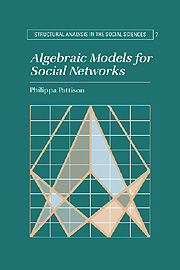Book contents
- Frontmatter
- Contents
- List of figures and tables
- Preface
- 1 Algebraic representations for complete social networks
- 2 Algebraic representations for local social networks
- 3 Comparing algebraic representations
- 4 Decompositions of network algebras
- 5 An analysis for complete and local networks
- 6 Time-dependent social networks
- 7 Algebras for valued networks
- 8 Issues in network analysis
- References
- Appendix A Some basic mathematical terms
- Appendix B Proofs of theorems
- Author index
- Subject index
4 - Decompositions of network algebras
Published online by Cambridge University Press: 21 October 2009
- Frontmatter
- Contents
- List of figures and tables
- Preface
- 1 Algebraic representations for complete social networks
- 2 Algebraic representations for local social networks
- 3 Comparing algebraic representations
- 4 Decompositions of network algebras
- 5 An analysis for complete and local networks
- 6 Time-dependent social networks
- 7 Algebras for valued networks
- 8 Issues in network analysis
- References
- Appendix A Some basic mathematical terms
- Appendix B Proofs of theorems
- Author index
- Subject index
Summary
The algebraic constructions that have been introduced to represent relational structure in complete and local social networks make few structural assumptions in the hope of preserving the faithfulness with which they represent the structure of network paths. A cost is associated with this approach, however, in that the mathematical structures generated have relatively weak and, generally, poorly understood mathematical and numerical properties. Clyde Coombs summarised the trade-off between the faithfulness of a model and its mathematical power when he asked of measurement, “Do we know what we want, or do we want to know?” (Linzell, 1975). Do we use what might be a poor representation of the data but which nonetheless has strong numerical properties or do we sacrifice mathematical power for a model whose mathematical relationships more adequately reflect known or, at least, plausible relationships among the social phenomena in question?
It is implicit in the structural representations that have been proposed that the latter course is believed to be the wiser one. Detailed analyses of social network data indicate that at this stage it is difficult to add mathematical properties to those already assumed without seriously misrepresenting at least some types of social network data. We are left, therefore, with structures that are often complex and for which we have no convenient methods of analysis. It is the aim of this chapter to describe some useful analytic procedures for structures of this kind.
- Type
- Chapter
- Information
- Algebraic Models for Social Networks , pp. 135 - 171Publisher: Cambridge University PressPrint publication year: 1993



